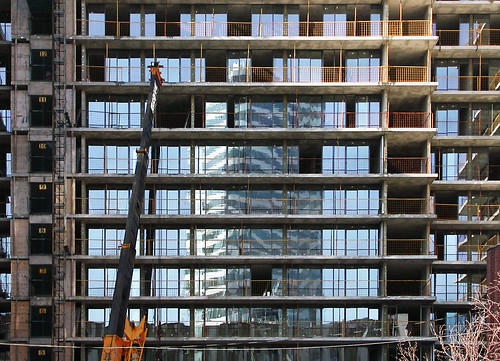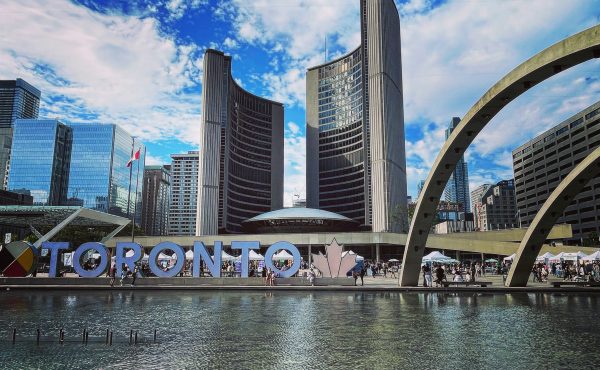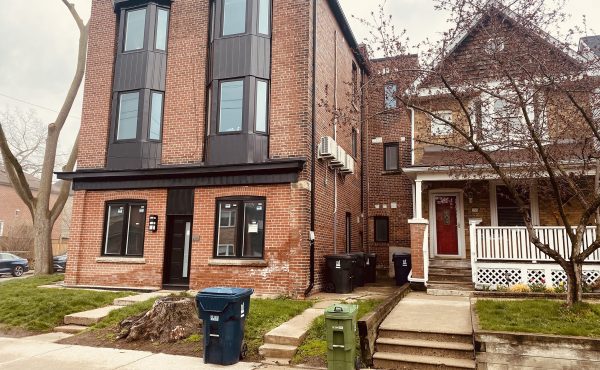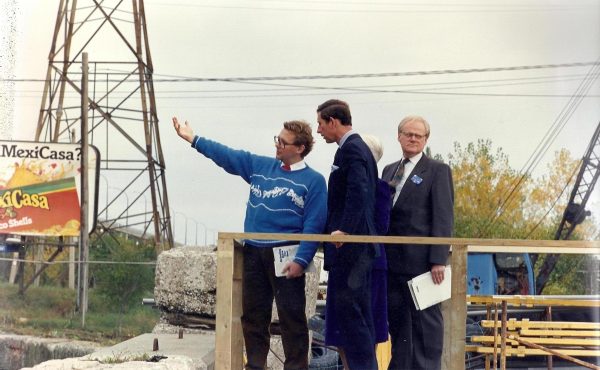

Not all wards are treated equally. Take Ward 20, watched over by well-known feather-ruffler Adam Vaughan. As of Oct. 27, the councillor had counted 71 different development applications in his ward, which includes a good chunk of the waterfront, Kensington Market and the Annex. Just to put that in perspective, Vaughan says that Councillor Shelley Carroll has been feeling overwhelmed by the number of developments taking place in her North York Ward. The grand total there: four.
“Councillor Kyle Rae, myself and Pam McConnell have something like 80 per cent of the all development in the city happening in our wards,†says Vaughan. And development is booming. Between 2001 and 2006, 17,000 residential units were built and newly inhabited downtown. Today, 39,000 new units are in the development pipeline for the same area.
Each new development necessitates community meetings, bargaining with developers and extracting information from planners. Dense condo developments require figuring out how injecting thousands of new residents into a neighbourhood will affect traffic, transit and the public realm. Numerous other questions have to be asked as well. Will the new developments include affordable units or family units? Will they be environmentally friendly? The list goes on and on. Now imagine an understaffed planning department and a single overworked councillor having to ask all these questions every single time someone wants to build a new vertical subdivision. (In Vaughan’s case, that means hosting community meetings every day of the week.) No wonder sometimes it seems that the easiest thing to do is leave local residents out of the mix.
Vaughan’s solution is to empower the people in his ward to do a bit of proactive planning to ensure that community concerns are put front and centre. To do this, he has enlisted the help of planning students from Ryerson and U of T to work with residents to produce community maps that show which areas are stable and which can handle growth. The students will also help compile “report cards†that outline agreed-upon standards by which developers can expect residents to assess proposed developments. This way, developers wishing to save money by avoiding lengthy community consultation can incorporate residents’ ideas into their designs from the beginning. The city’s planning department, meanwhile, will have clear direction on where to work and what to achieve. And the number of community meetings will decrease. At least that’s the idea.
In an era of cost containment, planning is an easy department to cut. “Save our secondary plans!†doesn’t have the same ring to it as “save our skating rinks!†which is why creative ideas like Vaughan’s are so sorely needed.
photo by Kevin Steele
– – – – – – – – – – – – – –
Dale Duncan writes the City hall column for Eye Weekly. Spacing posts her columns each Thursday — or, in this case, later the next week.




18 comments
I think it would be easier for Adam to handle the situation if he actually lived in the ward.It would also help if the city actually had a long term vision of the city instead of a hodge podge “take it as they come” plan.This will lead to chaotic development ,as it has and but a huge strain on our infrastructure.
Allowing the students to take part is a novel idea but really now they are students and I hope they won’t be used as cheap labour to take the heat of Adam.He ran knowing what the problems were with the office , or did he?
Yeah, having Vaughan live four blocks outside of the ward would really makes a difference.
There is a plan: The Official Plan. takes us to 2030.
Is there a web plug-in or something that can make George Sawision comments disappear? They’re consistently convoluted, off-topic and mildly defamatory and they take away from the quality of discussion on this otherwise exceptional blog.
Thanks
well then thats the point there is no problem is there?The only real problem here are the development fees that aren’t high enough and the management of the city which isn’t clear enough.Thanks for making my point Nathan for me.
George: I’ve been to several of the meetings about development in the ward, and I can categorically say that the approach being used by Vaughan in this ward is fully welcomed and embraced by those who participate.
I’m not sure what your point is about him living four blocks outside the ward – as he’s lived and worked in the ward for most of his life – and the main thing is how he does his job for those who live here. But the issues in the ward, are not just about those who live here, there are many people who work here or own businesses.
I am working with a group of “students” in my area, and they are actualy pleased to have a “real live” opportunity rather than a hypothetical situation.
I am a recent graduate of the University of Toronto’s Urban Studies program and I think it’s great Councillor Vaughan is inviting students to help him with this.
This is a great opportunity for students in gaining real-world experience, having a peek into the city’s planning process as well as getting a kick-ass reference. Even if students are “used as cheap labour,” this is when they need to pay their dues. I only wish I could have paid mine that way!
I had the pleasure of a chance meeting with Councillor Vaughan and his son one morning this past spring. I walking to work, he walking his son to school down Euclid and east on Queen. His son pointed and said “Look at all the cars!”
Me, having seen the previous days smog count and aware of the days smog warning responded “they are celebrating smog day”.
Adam got the joke. Development isn’t everything. Dealing with the by-products is the challenge. Blaming the victim is a cop out.
A councillor actually active in pedestrian land is a good thing. When they hide in climate controlled offices and motor vehicles oblivious to what life is really like outside, development tends to run counter to the interests of residents. Under the circumstances forgiving Mr Vaughan four measly blocks seems in order.
Now on the other hand there is one Tony Ruprecht ..
Tony Ruprecht, the MP even Liberals never see.
The Official Plan only makes sense if it is enforced. Oh well so much for the Official Plan.
George is completely right to note Vaughan’s ‘hodge podge “take it as they come” plan’. Secondary Plans developed through community consultation are a good thing, but only as long as they’re stuck to. Many of the questions cited (traffic, transit and the public realm) have already been comprehensively answered and built into the much coveted legal framework for ‘clear direction on where to work and what to achieve’ for the city’s planning department.
Unfortunately, the wheeling and dealing predominant over the past year (perhaps the reason for community meetings every day of the week) in the name of securing superficial ‘community benefits’ has created height and density precedents that have rendered the policy framework of the secondary plans useless – and the Planning Department ineffective.
Pleasurable chance meetings and real world student experience aside, expect unplanned Downtown built form to slide on over to Bathurst within a decade.
The way I read Juan and George is that they seem not to be engaged directly in neighbourhood activities in Ward 20. If they were, the commentary would not seem to be that of “armchair pontificators”.
The fact of the matter is that in this ward (20), the wheeling and dealing went on prior to the last election — since then the engagement under the current ward leadership has more rigour and definitely based on principles, not what Juan suggests are “superficial community beenfits”. What do you know that we don’t know.
I was going to mention that there’s an OP that everyone had an opportunity to have input when it was being drafted but my thunder was stolen. It’s perhaps one of the best documents ever to come out of the City. Too bad Council routinely ignores it. Too bad we feel people need to be “consulted” until they develop a rash from it…or die of old age. Too bad more councillors aren’t like Kyle Rae….He’s all over development because he knows it’s good for the city…density? he says bring it on….the more the better. Perfect, that’s what the downtown is for.
Too bad we waste so much money on OMB hearings and “consultation” – both the City and the developers. Most developers would LOVE to take, say, half that expenditure and just give it to the City to do whatever if only for an expeditious process…..too much to ask I know…I’ll win the 6/49 before something like that would ever happen.
I’m all in favour of students getting some real experience, but come on, do we really need “report cardsâ€Â??
Vaughan is opposed to the critical development of Toronto – increasing the density of Downtown and making a real 24-7 community throughout his ward. Kyle Rae appreciates and understands why so much development happens in his ward, but Vaughan only wants to oppose everything possible. But I forgot, Spacing would much rather keep all of the surface parking lots and 2-3 story buildings that make up Toronto’s current downtown (that which isn’t total wasteland, such as where Cityplace is going) then actually approve of any building.
If there are too many community meetings, then we should stop letting BANANAs obstruct needed development, mandated by Places to Grow and the OP, simply because it’s easier for politicians than telling immature leftists to grow up. Instead of caving into the forces of BANANA, council should be mandating minimum heights in the core and on principal streets.
Bloor St. should be exceptionally dense, since its our only east west subway route. The other main E-W axes should be at least 5 stories on the street and have enhanced density surrounding. But rational policy that ties into Spacing’s professed belief in transit is WRONG. We MUST OPPOSE EVERYTHING!!!
Vaughan is the worst councillor in the city thanks to his parochialism and faux-populism. I just hope he doesn’t get any memorials to his idiocy like the Crombie mandated 4 story Holt-Renfrew.
People named “reality check” are often full of rhetoric and loose facts not based in reality.
Shawn, I am not sure what you are alluding to. The picture in your link, and the area in general, is not in Ward 20.
Furthermore, do you think that Adam supports any intensification in his ward? I would like to know if he has in fact supported anything other than the status quo.
Glen> “Reality” said “But I forgot, Spacing would much rather keep all of the surface parking lots and 2-3 story buildings that make up Toronto’s current downtown”
And i posted a link to one of many posts that contradict “reality’s” statement about Spacing.
Ward 20 is another matter, you should ask Adam V. In the clubs vs. residents fight, he seems to be firmly behind the residents, who are mostly new, living in “intensified” buildings. I suspect you’re looking for black-and-white scenarios though, judging by the subtitle of your blog. So you should ask Adam yourself.
The “reality” is that density can be a very good thing, but that infrastructure must be in place for it to work.
And in order for that infrastructure to be in place, a developer must collaborate with both the city and local residents in order to achieve a balance.
You can’t just go about building 20 storey buildings willy-nilly.
Where will those condo dwellers eat?
Where will they get groceries?
Where will they take their dogs for a walk?
Where will they take their children to school?
Where will their waste water go?
How is this so complicated to understand?
It’s simple logistics.
Beth, I couldn’t agree more that infrastructure must be in place to accomodate intensification. It’s worth noting that the first two considerations you note are being addressed fairly quickly by private enterprise. The Dominion stores in the Merchandise building, Liberty Village, and College Park, the Valu-Mart in the Manulife Centre, the Sobeys Express stores on Yonge St, at Queens Quay, and soon somewhere on Front, the Fresh and Wild in the bottom of the new Hudson building… I could go on, but you get the idea. These stores have been built within walking distance of condos (and in condos), not necessarily at exactly the same time as development, but in ever-faster response to it. Not to mention that the majority of downtown condos are within walking/biking distance of a farmer’s market, Kensington, or St. Lawrence.
New restaurants, new bank branches, take-out places, dry cleaners, convenience stores… these services also sprout up reliably where there is new development/intensification.
The infrastructure concerns that aren’t being addressed are publicly-controlled ones such as transportation (lineups for the King Streetcar, bowing to pressure from restaurant owners not to have a dedicated lane/ban parking), parks (on the plus side, downtown parkettes have never been better-used), schools (though as Vaughan has observed, there aren’t many “family-style” condos being built), and an antiquated sewage system. If the city were able to follow the Official Plan without constant battles over this or that corner I wonder if it would be able to better prepare the ground for development? I’m not convinced of it, and we’ll never know, but it seems like in an ideal world, things might work that way.
“Vaughan has observed, there aren’t many “family-style†condos being built”
Thats probably because families who can afford not to live in apartment buildings…Don’t.